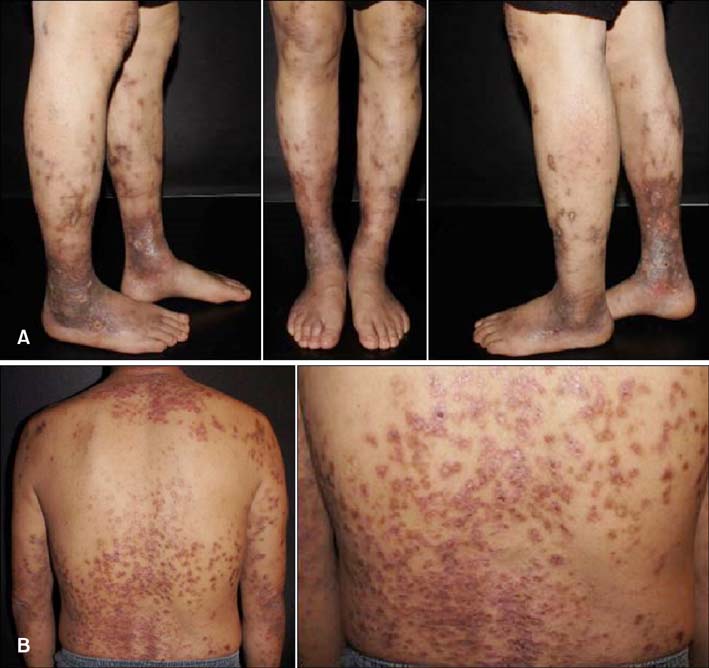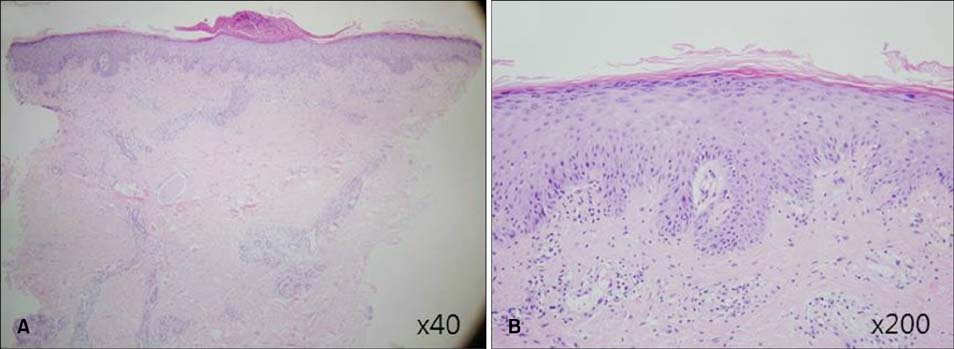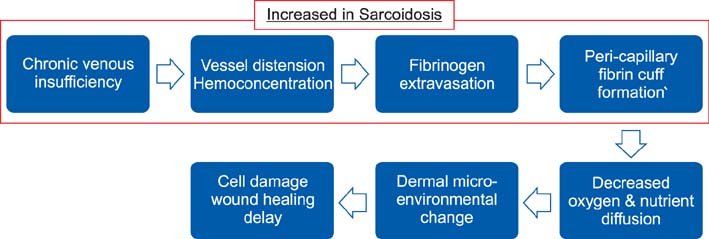Ann Dermatol.
2015 Dec;27(6):744-747. 10.5021/ad.2015.27.6.744.
Venous Leg Ulcer in a Sarcoidosis Patient: A Case Report
- Affiliations
-
- 1Department of Dermatology, Seoul National University Bundang Hospital, Seongnam, Korea. gcpark@snu.ac.kr
- KMID: 2157452
- DOI: http://doi.org/10.5021/ad.2015.27.6.744
Abstract
- Venous leg ulcers, the most common form of leg ulcers, are relevant to the pathogenicity of pericapillary fibrin cuff. Sarcoidosis, a multiorgan granulomatous disease, causes fibrin deposition in tissues. We report a case of a 50-year-old man with venous leg ulcers coexisting with sarcoidosis. On the basis of the histologic findings, we propose the hypothesis that sarcoidosis patients are prone to the development of venous leg ulcers.
Keyword
Figure
Reference
-
1. Scott TE, LaMorte WW, Gorin DR, Menzoian JO. Risk factors for chronic venous insufficiency: a dual case-control study. J Vasc Surg. 1995; 22:622–628.
Article2. Nelzén O, Bergqvist D, Lindhagen A. Venous and non-venous leg ulcers: clinical history and appearance in a population study. Br J Surg. 1994; 81:182–187.
Article3. Burnand KG, Whimster I, Naidoo A, Browse NL. Pericapillary fibrin in the ulcer-bearing skin of the leg: the cause of lipodermatosclerosis and venous ulceration. Br Med J (Clin Res Ed). 1982; 285:1071–1072.
Article4. Pardes JD, Tonneson MG, Falanga V, Eaglstein WH, Clark RAF. Skin capillaries surrounding chronic venous ulcers demonstrate smooth muscle hyperplasia and increased laminin type IV collagen. J Invest Dermatol. 1990; 94:563.5. Moyses C, Cederholm-Williams SA, Michel CC. Haemoconcentration and accumulation of white cells in the feet during venous stasis. Int J Microcirc Clin Exp. 1987; 5:311–320.6. Falanga V, Kruskal J, Franks JJ. Fibrin- and fibrinogen-related antigens in patients with venous disease and venous ulceration. Arch Dermatol. 1991; 127:75–78.
Article7. Falanga V. Venous ulceration. J Dermatol Surg Oncol. 1993; 19:764–771.
Article8. Statement on sarcoidosis. Joint Statement of the American Thoracic Society (ATS), the European Respiratory Society (ERS) and the World Association of Sarcoidosis and Other Granulomatous Disorders (WASOG) adopted by the ATS Board of Directors and by the ERS Executive Committee, February 1999. Am J Respir Crit Care Med. 1999; 160:736–755.9. Kang MJ, Kim HS, Kim HO, Park YM. Cutaneous sarcoidosis presenting as multiple erythematous macules and patches. Ann Dermatol. 2009; 21:168–170.
Article10. Goldsmith LA, Katz SI, Gilchrest BA, Paller AS, Leffell DJ, Wolff K. Fitzpatrick's dermatology in general medicine. 8th ed. New York: McGraw-Hill Professional;2012. p. 1869–1880.11. Quismorio FP Jr, Sharma OP, Chandor S. Immunopathological studies on the cutaneous lesions in sarcoidosis. Br J Dermatol. 1977; 97:635–642.
Article12. Perez RL, Duncan A, Hunter RL, Staton GW Jr. Elevated D dimer in the lungs and blood of patients with sarcoidosis. Chest. 1993; 103:1100–1106.
Article13. Shorr AF, Hnatiuk OW. Circulating D dimer in patients with sarcoidosis. Chest. 2000; 117:1012–1016.
Article
- Full Text Links
- Actions
-
Cited
- CITED
-
- Close
- Share
- Similar articles
-
- Subcutaneous Sarcoidosis of the Distal Lower Leg in a Middle-Aged Woman Associated with Pulmonary Sarcoidosis: a Case Report
- A Case of Antiphospholipid Syndrome in A Patient with Leg Ulcer and Previous History of Deep Vein Thrombosis
- Vein Crossover Bypass Surgery for a Chronic Femoral Vein Ligation: A case report
- A Case of Ichthyosiform Sarcoidosis
- Optimal Diagnosis and Therapy of Venous Ulcer





